
Jethro Tull are a British rock band formed in Blackpool, Lancashire in 1967. Initially playing blues rock and jazz fusion, the band soon incorporated elements of English folk music, hard rock and classical music, forging a signature progressive rock sound. The group's founder, bandleader, principal composer, lead vocalist, and only constant member is Ian Anderson, a multi-instrumentalist who mainly plays flute and acoustic guitar. The group has featured a succession of musicians throughout the decades, including significant contributors such as guitarists Mick Abrahams and Martin Barre ; bassists Glenn Cornick, Jeffrey Hammond, John Glascock, Dave Pegg, Jonathan Noyce, and David Goodier; drummers Clive Bunker, Barrie "Barriemore" Barlow and Doane Perry; and keyboardists John Evan, Dee Palmer, Peter-John Vettese, Andrew Giddings, and John O'Hara.

Thick as a Brick is the fifth studio album by the British rock band Jethro Tull, released on 3 March 1972. The album contains one continuous piece of music, split over two sides of an LP record, and is intended as a parody of the concept album genre. The original packaging, designed as a 12-page newspaper, claims the album to be a musical adaptation of an epic poem by fictional eight-year-old genius Gerald Bostock, though the lyrics were actually written by the band's frontman, Ian Anderson.

Heavy Horses is the eleventh studio album by British progressive rock band Jethro Tull, released on 10 April 1978.

A is the 13th studio album by British rock band Jethro Tull. It was released on 29 August 1980 in the UK and 1 September of the same year in the United States.

Ian Scott Anderson is a British musician best known for his work as the singer, flautist, acoustic guitarist, primary songwriter, and sole continuous member of the rock band Jethro Tull. He is a multi-instrumentalist who also plays harmonica, keyboards, bass guitar, bouzouki, balalaika, saxophone and a variety of whistles. His solo work began with Walk into Light in 1983; since then he has released another five albums, including the sequel to the 1972 Jethro Tull album Thick as a Brick, titled TaaB 2: Whatever Happened to Gerald Bostock? (2012).

Roots to Branches is the 19th studio album by the British band Jethro Tull released in September 1995. It carries characteristics of Tull's classic 1970s progressive rock and folk rock roots alongside jazz and Arabic and Indian influences. All songs were written by Ian Anderson and recorded at his home studio. This is the last Tull album to feature Dave Pegg on the bass, and the first to feature keyboardist Andrew Giddings as an official band member, although he had contributed to Catfish Rising (1991) on a sessional basis. As a result, the album notably features the five longest serving members to date in Jethro Tull’s history. It was also the final Tull album to be released through long-time label Chrysalis Records.

This Was is the debut studio album by the British rock band Jethro Tull, released in October 1968. Recorded at a cost of £1200, it is the only Jethro Tull album with guitarist Mick Abrahams, who was a major influence for the sound and music style of the band's first songs. When the album was released the band were performing regularly at the Marquee Club in London, where other successful British groups, such as the Rolling Stones and the Who, had started their careers.

Stand Up, released in 1969, is the second studio album by British rock band Jethro Tull. It was the first Jethro Tull album to feature guitarist Martin Barre, who would go on to become the band's longtime guitarist until its initial dissolution in 2012. Before recording sessions for the album began, the band's original guitarist Mick Abrahams departed from the band as a result of musical differences with frontman and primary songwriter Ian Anderson; Abrahams wanted to stay with the blues rock sound of their 1968 debut, This Was, while Anderson wished to add other musical influences such as folk rock.

Minstrel in the Gallery is the eighth studio album by British rock band Jethro Tull, released in September 1975. The album sees the band going in a different direction from their previous work War Child (1974), returning to a blend of electric and acoustic songs, in a manner closer to their early 1970s albums such as Benefit (1970), Aqualung (1971) and Thick as a Brick (1972). Making use of a newly constructed mobile recording studio commissioned and constructed specifically for the band, the album was the first Jethro Tull album to be recorded outside of the UK, being recorded in tax exile in Monte Carlo, Monaco.

Benefit is the third studio album by the British rock band Jethro Tull, released in April 1970. It was the first Tull album to include pianist and organist John Evan – though he was not yet considered a permanent member of the group – and the last to include bass guitarist Glenn Cornick, who was fired from the band upon completion of touring for the album. It was recorded at Morgan Studios, the same studio where the band recorded its previous album Stand Up; however, they experimented with more advanced recording techniques.

Martin Lancelot Barre is an English guitarist best known for his longtime role as lead guitarist of British rock band Jethro Tull, with whom he recorded and toured from 1968 until the band's initial dissolution in 2011. Barre played on all of Jethro Tull's studio albums from their 1969 album Stand Up to their 2003 album The Jethro Tull Christmas Album. In the early 1990s he began a solo career, and he has recorded several albums as well as touring with his own live band.

Bursting Out is a 1978 live double album by the rock band Jethro Tull. The album was recorded during the band's European Heavy Horses Tour in May/June of that year.

Crest of a Knave is the sixteenth studio album by British rock band Jethro Tull, released in 1987. The album was recorded after a three-year hiatus caused by a throat infection of vocalist Ian Anderson, resulting in his changed singing style. Following the unsuccessful electronic rock album Under Wraps, Crest of a Knave had the band returning to a more hard rock sound. The album was their most successful since the 1970s and the band enjoyed a resurgence on radio broadcasts, appearances in MTV specials and the airing of music videos. It was also a critical success, winning the 1989 Grammy Award for Best Hard Rock/Metal Performance Vocal or Instrumental in what was widely viewed as an upset over the favorite, Metallica's ...And Justice for All. The album was supported by "The Not Quite the World, More the Here and There Tour".

Bourrée in E minor is a popular lute piece, the fifth movement from Suite in E minor BWV 996 written by Johann Sebastian Bach between 1708 and 1717. The piece is arguably one of the most famous among guitarists.

Thick as a Brick 2, abbreviated TAAB 2 and subtitled Whatever Happened to Gerald Bostock?, is the fifth studio album by Jethro Tull frontman Ian Anderson, released in 2012 as a sequel album to Thick as a Brick, Jethro Tull's 1972 parody concept album. It entered the Billboard chart at No. 55.

Scott Hammond is an English drummer. He plays with Ian Anderson and has also toured and recorded with Jethro Tull itself. He has been described as a "Jazz drummer with rock influences".

"A Song for Jeffrey" is a song recorded by the English rock band Jethro Tull, released as their second single in the UK, and as the B-side to "Love Story" in the US. The "Jeffrey" of the title is Ian Anderson's friend and future Jethro Tull bassist Jeffrey Hammond, who was "a slightly wayward lad who wasn’t quite sure where he was headed in life".

The Zealot Gene is the 22nd studio album by the British rock band Jethro Tull, released on 28 January 2022 by Inside Out Music. Nearly five years in production, it is their first studio album since The Jethro Tull Christmas Album (2003), and their first of all original material since J-Tull Dot Com (1999), marking the longest gap between the band's studio albums.

RökFlöte is the 23rd studio album by the British progressive rock band Jethro Tull, released on 21 April 2023.



















